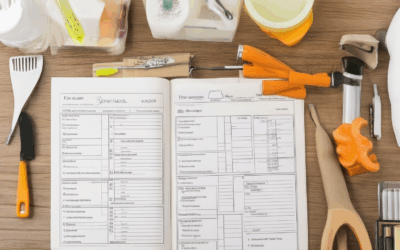Keeping your house in top shape is crucial, especially when it comes to seasonal upkeep. With fluctuating temperatures, unpredictable weather patterns, and varying seasonal demands, homeowners often struggle to maintain their properties effectively. Whether it’s preparing for harsh winters or ensuring your home stays cool during summer months, seasonal upkeep requires a thoughtful approach to preserve both the structural integrity and aesthetic appeal of your house. This comprehensive guide will walk you through the essential tasks, provide practical tips, and offer expert advice to help you create a robust home maintenance routine tailored to your needs. From annual checklists to seasonal-specific care, we’ll cover everything you need to know to keep your house in prime condition year-round.
Key Takeaways
– Exterior Checks: Regularly inspect roofs, siding, and gutters to prevent costly repairs and ensure curb appeal.
– Interior Systems: Schedule annual HVAC tune-ups, plumbing checks, and electrical inspections to maintain functionality and safety.
– Landscape Care: Trim trees, mow lawns, and maintain sprinklers to keep your yard healthy and visually appealing.
– Attic and Crawl Space Inspections: Address moisture issues and ensure structural integrity with regular checks.
– Bathroom and Kitchen Maintenance: Detect leaks early and ensure appliances function properly to prevent damage and waste.
– Fire Safety Measures: Test smoke detectors and keep fire extinguishers ready to protect your home.
– Budgeting and Documentation: Set aside funds for maintenance and keep detailed records of all home checks.
– Professional Help: Hire experts for specialized tasks like HVAC servicing and plumbing inspections to ensure quality work.

What Maintenance Does a House Need Every Year?
Annual home maintenance is essential to ensure your property remains in great shape and avoids costly repairs. Here’s a detailed checklist to guide you through the necessary tasks:
Exterior Maintenance
- Roof Inspection: Check for missing shingles, curled edges, or damage caused by weather.
- Siding Check: Look for peeling paint, warping, or signs of rot.
- Window and Door Frames: Inspect for cracks, gaps, or damage that may affect insulation and security.
- Gutter and Downspout Cleanliness: Remove debris to ensure proper drainage and prevent water damage.
- Deck and Walkway Safety: Check for loose boards, rust, or structural issues.
- Pressure Washing: Clean exterior surfaces to remove dirt, grime, and mildew buildup.
Interior Maintenance
- Flooring: Look for loose tiles, uneven spots, or wear and tear.
- Wall Checks: Inspect for peeling paint, stains, or signs of water damage.
- Plumbing Leaks: Examine under sinks, around pipes, and behind appliances for leaks.
- Appliance Maintenance: Clean vents, check the dryer vent, and inspect the water heater for leaks.
- Smoke Detectors and Carbon Monoxide Sensors: Test and reset to ensure they’re functioning properly.
Heating, Ventilation, and Air Conditioning (HVAC)
- Clean or Replace Filters: Ensure air quality and efficiency by cleaning or replacing filters as needed.
- Ductwork Inspection: Check for blockages, leaks, or rodents.
- Thermostat Functionality: Test programmability and ensure it’s operating correctly.
Plumbing and Water Systems
- Water Pressure and Pipes: Check for leaks or mineral buildup in pipes.
- Hot Water Heater: Inspect for leaks and ensure it’s functioning efficiently.
- Irrigation System: Check for leaks, clogs, or malfunctioning zones.
Electrical Systems
- Outlets and Switches: Test for functionality and check for any tripping issues.
- Light Fixtures: Inspect for loose bulbs, flickering lights, or broken parts.
- Ground Fault Circuit Breaker: Ensure it’s working properly to protect against electrical hazards.
Landscaping and Yard Care
- Grading and Drainage: Ensure proper water runoff away from the house to prevent foundation issues.
- Trimming Trees and Shrubs: Maintain clearance from the house and remove diseased plants.
- Pest Control: Inspect for signs of insects or pests that may damage the property.
- Irrigation System Check: Ensure efficient watering and proper coverage to maintain lawn health.
Additional Tips
- Chimney and Flue inspection: Check for cracks or blockages to prevent fire hazards.
- Sump Pump Functionality: Ensure it’s working correctly to handle basement moisture.
- Attic Access and Insulation: Check for rodent activity and ensure insulation is in good condition.
By addressing these maintenance tasks annually, you’ll extend the life of your home and ensure it remains a safe and comfortable place to live. For more detailed guides on each of these tasks, visit our Home Maintenance Guides section.
Seasonal Maintenance
Seasonal maintenance is essential for ensuring your home remains in optimal condition throughout the year. It involves a series of tasks tailored to address the unique challenges each season presents. Below is a breakdown of key seasonal maintenance activities:
- Spring Maintenance
- Clean and inspect gutters and downspouts to remove debris.
- Check and service your HVAC system to ensure it’s ready for warmer weather.
- Inspect and treat wood decks for damage caused by moisture and pests.
- Prune trees and shrubs to maintain proper growth and visibility.
- Summer Maintenance
- Service your air conditioning unit to ensure efficiency during hot months.
- Check for and repair any leaks in outdoor plumbing systems.
- Inspect and clean your pool and spa equipment to prevent bacteria growth.
- Trim grass and weeds to maintain lawn health and appearance.
- Fall Maintenance
- Rake and bag leaves from your lawn and garden areas.
- Check your roof for missing shingles or damage caused by weather.
- Service your heating system to prepare for cooler temperatures.
- Inspect windows and doors for drafts and seal leaks.
- Winter Maintenance
- Clean and store outdoor furniture to protect it from harsh weather.
- Service your car before winter to prevent freezing issues.
- Check for and fix any frozen pipes or water damage.
- Inspect your property for potential ice dams on roofs and gutters.
By adhering to these seasonal maintenance tasks, you can extend the lifespan of your home and ensure it remains in great shape year-round. Properly addressing each season’s unique demands helps prevent costly repairs and keeps your living spaces comfortable and safe.

What is the Uphelp of a House?
The upkeep of a house refers to the routine maintenance and care required to preserve its condition, safety, and functionality. Proper upkeep ensures that the house remains comfortable, durable, and visually appealing. Here’s a detailed guide to maintaining your home effectively:
Exterior Maintenance
- Roof Inspection: Check for missing shingles, cracks, or damage. Replace or repair as needed.
- Painting: Regularly repaint exterior surfaces to protect against weather damage and maintain curb appeal.
- Tree Pruning: Trim branches that hang over roofs, walkways, or power lines to prevent damage and blockage.
- Driveway and Walkway Maintenance: Clean debris, crack filler, and inspect for uneven surfaces or potholes.
Interior Maintenance
- Wall Cleaning: Dust, wash, or repaint walls to maintain a fresh appearance and prevent dirt buildup.
- Floor Care: Vacuum, mop, or sweep floors regularly to keep them clean and extend their lifespan.
- Window Cleaning: Remove dust, grime, or fingerprints to ensure optimal energy efficiency and visibility.
- Pest and Mold Inspection: Look for signs of pests or mold growth and address issues promptly to prevent health hazards.
Systems Maintenance
- HVAC System: Change or clean filters monthly, inspect ductwork annually, and schedule tune-ups twice a year.
- Plumbing: Check for leaks, clogs, or discolored water, and address issues immediately to prevent costly repairs.
- Electrical Systems: Inspect outlets, switches, and wiring for damage or wear, and test GFCIs to ensure safety.
- Appliances: Clean and maintain cooking ranges, refrigerators, and laundry units to ensure proper functioning.
Seasonal Tasks
- Winter Preparation: Clear gutters, check for ice dams, and insulate pipes to prevent freezing and damage.
- Summer Preparation: Seal windows, inspect air conditioning units, and prepare for heavy rain or storm damage.
Minor Repairs and Improvements
- Fix Leaks Quickly: Address water leaks promptly to prevent structural damage and mold growth.
- Replace Worn Out Items: Update old caulking, seals, or weatherstripping to improve energy efficiency and security.
- Upgrade Outdated Features: Consider replacing outdated fixtures, flooring, or appliances to modernize your space.
By staying proactive with these maintenance tasks, you can protect your home, save money on repairs, and enjoy a safer, more comfortable living environment. Regular upkeep also helps maintain your home’s resale value and ensures longevity for years to come.
Learn more about professional home maintenance services or explore DIY tips for homeowners .

Creating a House Maintenance Plan
A well-structured house maintenance plan is essential for preserving the value and functionality of your home. Below is a comprehensive guide to help you get started.
Exterior Maintenance
- Roof Inspection: Check for missing shingles, leaks, or damaged flashing. Inspect twice a year, preferably in spring and fall.
- Siding Check: Look for cracks, peeling paint, or rot. Inspect annually or after noticing issues.
- Gutter Cleaning: Remove debris and check for leaks. Clean at least twice a year, especially after stormy weather.
Interior Systems
- HVAC Service: Schedule annual tune-ups to ensure optimal performance and energy efficiency. Replace filters monthly.
- Plumbing Check: Look for leaks under sinks, around pipes, and near appliances. Test water pressure and inspect for corrosion.
- Electrical Systems: Test circuit breakers, GFCIs, and outlets. Inspect wires for fraying or damage. Check monthly.
Landscape Maintenance
- Tree and Shrub Trimming: Trim trees and shrubs to prevent damage and ensure proper growth. Do this twice a year.
- Lawn Care: Check for pests, diseases, and weeds. Mow, fertilize, and aerate the lawn as needed, typically every three months.
- Sprinkler System: Turn on and test the sprinklers at the start of each season. Adjust settings as needed to prevent overwatering.
Attic, Basement, and Crawlspace
- Attic Insulation: Check for pests, moisture, and sagging beams. Insulate and seal leaks to improve energy efficiency.
- Basement Moisture Control: Look for water stains or mold growth. Address leaks promptly and consider installing a sump pump if needed.
- Crawlspace Inspection: Clean debris, check for pests, and inspect structural supports. Ensure proper ventilation to prevent moisture buildup.
Kitchen and Bathroom Maintenance
- Leak Detection: Check under sinks, around tubs, and behind appliances for water leaks. Inspect monthly.
- Appliance Functionality: Test dishwashers, refrigerators, and garbage disposal units monthly. Ensure they operate efficiently.
- Bathroom Fixtures: Check for loose tiles, grout cracks, and water damage. Inspect showerheads and drains for clogs.
Fire Safety
- Smoke Detectors: Test smoke detectors and carbon monoxide detectors monthly. Replace batteries as recommended by the manufacturer.
- Fire Extinguishers: Check expiration dates and ensure they are fully charged. Practice using fire extinguishers annually.
Documentation and Budgeting
- Keep Records: Maintain a log of all maintenance activities, including dates, tasks performed, and any issues identified.
- Set Aside Funds: Allocate money for unexpected repairs and regular maintenance. A common recommendation is to set aside 0.5-1% of your home’s value annually.
Professional Consultation
- Expert Inspections: Consider hiring professionals for tasks like HVAC system inspections or plumbing issues to ensure accuracy and safety.
- Regular Servicing: Schedule annual services for heating, cooling, and air quality systems to maintain peak performance.
By following this maintenance plan, you can extend the life of your home, reduce repair costs, and ensure a safe and comfortable living environment. Regularly review and update the plan as needed to adapt to your family’s changing needs and lifestyle.
Typical House Maintenance Costs
The average annual home maintenance costs range from $4,000 to $22,000 , varying based on factors like property size, age, location, and local labor rates. To ensure your home stays in great shape, it’s essential to budget wisely. Here’s a breakdown of common expenses:
1. Utilities and Systems
- Heating, Ventilation, and Air Conditioning (HVAC) : $300-$1,200 quarterly for repairs and inspections.
- Plumbing : $100-$500 annually for fixes and replacements.
- Electrical : $150-$600 yearly for updates and inspections.
2. Exterior Maintenance
- Painting : $1,500-$5,000 every 3-5 years for walls, fences, and decks.
- Roofing : $400-$1,500 annually for inspections and minor repairs.
- Landscaping : $50-$200 monthly for lawn care and yard work.
3. Appliances
- Refrigerator : $100-$300 annually for checks and potential repairs.
- Washing Machine : $100-$300 yearly for maintenance and parts.
- Water Heater : $100-$500 annually for inspections and tank cleaning.
4. Lawn Care and Yard Work
- Mowing : $20-$60 monthly, depending on lawn size.
- Weeding and Trimming : $15-$50 monthly.
- Fertilization and Pest Control : $100-$300 annually.
5. Minor Repairs
- Fixing Leaks : $100-$300 for plumbing or roof leaks.
- Patchwork : $100-$500 for drywall, flooring, or siding repairs.
6. Preventative Maintenance
- Home Warranty : $300-$600 annually for peace of mind.
- Regular Inspections : $100-$300 annually for systems like HVAC and plumbing.
Tips for Reducing Costs
- Schedule regular check-ups to catch issues early.
- Consider a home warranty for added protection.
- DIY simple tasks like fixing a leak or painting a room.
For professional assistance, visit Sams Maintenance or explore services from trusted providers like HomeAdvisor or Fixer Upper .

What is a Full Maintenance Plan?
A full maintenance plan is a service agreement that covers routine maintenance for your vehicle, protecting you from the high costs of unexpected repairs and ensuring your car stays in optimal condition. Here’s a breakdown of what it typically includes:
- Regular Servicing: Covers standard maintenance tasks like oil changes, tire rotations, and fluid replacements to keep your vehicle running smoothly.
- Wear and Tear Coverage: Replaces costly parts due to normal wear and tear, such as brakes, tires, and suspension systems.
- Mechanical Failures: Protects against unexpected issues like engine and transmission malfunctions, which can be expensive to fix.
- Multi-Point Inspections: Includes thorough checks to identify potential issues before they become major problems.
Choosing a full maintenance plan can save you money in the long run by preventing costly repairs and extending your vehicle’s lifespan. Many plans also offer peace of mind knowing your car is being serviced by certified professionals.
What Doesn’t a Full Maintenance Plan Cover?
- Accidents: Damage caused by collisions or accidents is typically excluded.
- Normal Wear and Tear: While some plans cover wear and tear, others may have limitations.
- Damage from Misuse: Issues resulting from poor driving habits or neglect are usually not covered.
Alternative Options
If a full maintenance plan doesn’t meet your needs, consider:
- Basic Plans: Limited to specific components or services, offering less coverage than a full plan.
- Custom Plans: Tailored to your vehicle’s unique requirements, combining elements of basic and full plans.
Example: Oil changes and tire rotations only.
Examples of Providers
Some popular providers include:
- Sam’s Club: Offers competitive maintenance plans with flexible terms. [Visit Sam’s Club](https://www.samsclub.com)
- AutoZone: Provides extended warranties and maintenance plans for various vehicle makes. [Visit AutoZone](https://www.autozone.com)
- Car Care Centers: Known for their reliable and affordable maintenance services. [Visit Car Care Centers](https://www.carcarecenters.com)
Conclusion
A full maintenance plan is a smart investment for anyone who wants to protect their vehicle and avoid unexpected repair costs. Evaluate your driving habits and vehicle needs to choose the best plan for your situation.




0 Comments